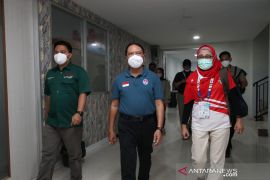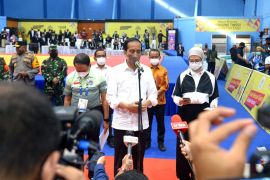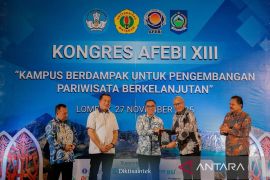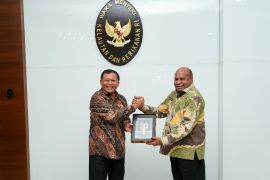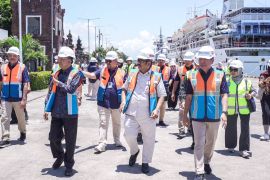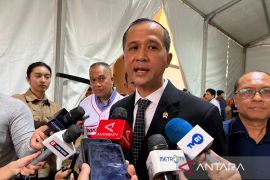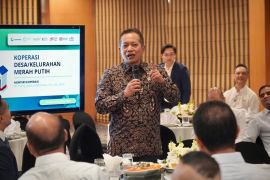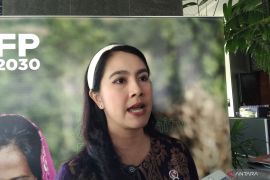The mothers are diligent and patient while drawing the batik patterns. They are happy they could introduce Papua arts and culture that are manifested in the Port Numbay batik patternsJayapura, Papua (ANTARA) - Papuan mothers’ skilled hands steadily draw intricate and distinct patterns to create a batik fabric popularly known as Port Numbay.
The Port Numbay batik was initiated by Jimmy Afaar, a native Papuan, by combining patterns from Papua’s 250 ethnic groups. His creation has been proven popular among domestic and international markets, and it provides more choices for visitors looking for locally-made crafts.
Despite his current official duties for the Papua women’s volleyball team at the PON XX National Games, Afaar has not ceased to assist the mothers to complete orders and promote the fabric.
Recalling the inception of Port Numbay batik, Afaar said his greatest motivation for developing the batik was to empower local mothers, who were skilled in weaving or painting yet received no economic gain from their skills.
Afaar decided to exploit the popularity of batik, recognized as a Masterpiece of Oral and Intangible Heritage of Humanity by UNESCO in 2009, to enhance local mothers’ livelihood and empower them.
Related news: PON seen boosting Papua economy by 1.5 percent: official
“We want to empower the mothers economically to allow them earning a living not only for daily foods but also to pay for their offsprings’ school tuition,” Afaar, who is also known as Opa by those close by him, said.
To fulfill his goal, Afaar decided to go to Java Island to study the batik-making process. After spending years gaining experience, he decided to return home and share his newly acquired knowledge of batik with local mothers.
Empower local mothers and inspire creative economy
Upon returning to his native land, he began his first mission: he needed to convince the mothers to participate in his endeavor. He later asked his cousin to persuade her friends to join the batik-making class, and 15 mothers gathered in his early batik classes 17 years ago.
To further hone the mothers’ batik-making skills, Afaar invited batik trainers from Yogyakarta to hold batik classes for them. Besides batik-making skills, he also taught the mothers time management so they could balance their house chores and batik production.
Afaar also introduced more intricate and diverse batik patterns as the mothers’ ability increased over time. Starting from bird-of-paradise patterns, he gave the women the liberty to create and innovate with new patterns.
Once the women began to accumulate completed batik fabrics, Afaar was ready for his second mission: Searching for potential markets and selling the batik. He relied upon a connection with government employees for his first batik orders.
Related news: Local MSMEs derives benefit from Papua PON
“I started the marketing process by promoting the batik from door to door. I also called my friend who worked in the Governor’s office and brought the batik fabric to their office. I often commuted in a public bus to sell the batik fabric, and my batik began to attract more buyers,” said Afaar, recounting his struggle in building the Port Numbay batik business.
Despite the fatigue of commuting far distances to sell batik, Afaar’s spirit quickly returned when he saw the happy faces of women empowered and able to earn a living on their own. He said his batik products truly embody a “from mothers, by mothers, and to mothers” spirit.
His tireless efforts began to bear fruit once foreign tourists began to favor the Port Numbay batik, and the mothers participating in the production process became more enthused to finish more batik fabrics.
“The mothers are diligent and patient while drawing the batik patterns. They are happy they could introduce Papua arts and culture that are manifested in the Port Numbay batik patterns,” Afaar said.
At present, Afaar sells two-meter batik fabric for Rp600 thousand (around US$42), two-and-a-half meter batik fabric for Rp650 thousand (around US$45.5), and three-meter batik fabric for Rp700 thousand (around US$49).
The PON XX National Games currently hosted in Papua province have also brought economic advantage to mothers producing the batik. Afaar said he had to hire more women and pay them on a daily basis to satisfy the increasing demand for the batik fabric.
“We started only with 15 mothers, and currently we have 36 mothers who have joined our endeavor to create batik with us. To accommodate the increasing demand during the PON Games, we even resorted to hiring more mothers that would be paid daily,” Afaar added.
Message of peace, diversity from Papua
Afaar’s simpler designs and patterns that were utilized earlier in the Port Numbay batik have over time been eclipsed by new symbols and motifs deliberately conceived by him to introduce Papuan ethnic groups to the world.
The diverse designs include farming utensils, marine resources from coastal tribes, and Noken – a local woven bag native to Papua – as an auspicious symbol of blessing. Those symbols have been introduced by Afaar to depict Papua’s natural and cultural diversity.
Related news: PON will boost Papua's economy: official
The message of peace conveyed by the Port Numbay batik later brought a special mission for him when he was assigned to create batik designs for President Joko Widodo and the First Lady Iriana in 2015.
To complete the task, he decided to draw a boat and paddle pattern -- a symbol of command among the Tobati and Enggros ethnic groups native to Jayapura – in the batik fabric for the President as an expression of hope for his successful leadership.
“In our customs, when the tribe leader directed the rowers to row the boat, the leader should ensure the boat would safely reach the destination no matter how huge the waves, winds, or other obstacles they should brave,” Afaar said.
Afaar expressed hope his endeavor, besides successfully empowering Papuan mothers, would also successfully introduce the message of peace and diversity from Papua to the world.
“All of the patterns conceived in the Port Numbay batik embodied social or cultural values. We did not include any patterns that might be interpreted as symbols of violence or discrimination because our main goal is to convey the message of peace and unity for Indonesia,” Afaar remarked.
Related news: PLN assures of electricity supply post PON
Related news: Jayapura KONI encourages development of sports tourism in Papua
Translator: Livia Kristianti, Nabil Ihsan
Editor: Fardah Assegaf
Copyright © ANTARA 2021


